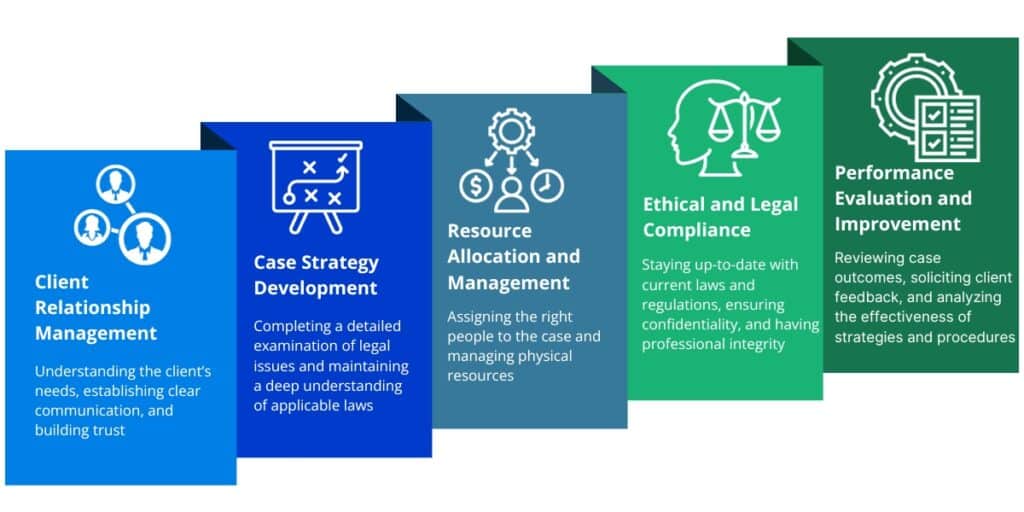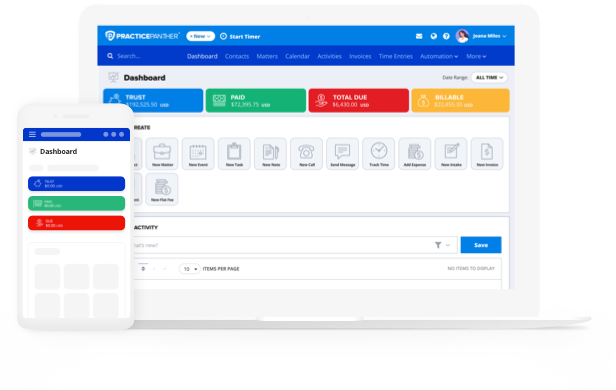Every legal professional has felt the pains of a chaotic day; they always go something like this:
- Your morning begins with an avalanche of paperwork from yesterday, and you can’t find that vital document you need for an upcoming trial.
- You’re swamped with client meetings, the phone ringing in the background with other clients who need your attention.
- An important and time-sensitive email slips unnoticed into your overflowing inbox.
- You need to prepare multiple pleadings before the court closes for the day, but time is ticking away.
- At the end of the day, tracking billable hours becomes a guessing game as you try to recall the time you spent on the multitude of cases you touched today.
It’s moments like these where legal case management software can truly come to the rescue. The various features and tools in such software can turn chaotic days like these into orderly, efficient ones. Imagine…
- You can find any paperwork you need with a few clicks of your mouse.
- Your clients need fewer appointments and phone calls because they can access their case status via a client portal.
- You actually have time to tend to your email inbox, so nothing gets lost in the shuffle.
- You meet deadlines days in advance due to smart calendaring and integrated court rules-based automation.
- You bill for each task as you go with automated time trackers, so every minute is accounted for.
If you’d prefer that your workday look like this, then you need legal case management software. This blog will explore the best case management tools in such software, how they are used, and the optimal ways to manage your cases with these tools.
What Are Case Management Tools?
Case management tools typically refer to features within case management platforms designed to assist legal professionals in organizing and managing their cases. These range from basic features, like timers to accurately record billable hours, to more complex tools, like custom reports that help you understand the ins and outs of your business.
In essence, all of these productivity tools for lawyers create a comprehensive solution designed to facilitate every aspect of all case management approaches. By integrating various functionalities, these tools alleviate the administrative burden on legal professionals, allowing them to focus more on the strategic—and billable—aspects of their cases.
Before we dig into the details of a good case management toolkit, let’s explore the basic components of case management. A comprehensive understanding of how case management works serves as a foundation for better appreciating how software tools best serve legal professionals.
What Are The 5 Components of Case Management?
Case management in the legal field is built on several fundamental components that form the backbone of case management and are essential in a legal professional’s toolkit. These principles of case management include:

1. Client Relationship Management
At the heart of case management is the relationship between the lawyer and the client. This relationship involves understanding the client’s needs, establishing clear communication, and building trust. A lawyer who will see repeat business is adept at sympathizing with client concerns while also setting achievable expectations. Maintaining strong client relationships often leads to successful case outcomes and contributes to a law firm’s reputation and client retention.
2. Case Strategy Development
Developing a solid case strategy is fundamental. Strategy development involves a detailed examination of legal issues and a deep understanding of applicable laws. Lawyers consider what the client aims to achieve, assess risks, and evaluate possible results to tailor each case strategy. This component is a mix of creative problem-solving as well as the ability to anticipate and counter opposing arguments.
3. Resource Allocation and Management
Effective case management requires the efficient allocation and management of resources. This part of case management includes assigning the right people to the case—lawyers, paralegals, and administrative staff. It also involves managing physical resources, like research materials, trial equipment, and office supplies. Proper resource management ensures that each case gets the attention it deserve—without overburdening staff or overshooting budgets.
4. Ethical and Legal Compliance
Adhering to legal and ethical standards is a cornerstone of the practice of law. Legal professionals must stay up-to-date with current laws and regulations, ensure confidentiality, and maintain professional integrity at every turn. As stewards of the law, attorneys must uphold the principles of justice and fairness. This component is vital in preserving the law firm’s credibility and trustworthiness, as well as preserving respect for the legal profession as a whole.
5. Performance Evaluation and Improvement
Continuous evaluation and improvement of case management processes are critical. This includes reviewing case outcomes, soliciting client feedback, and analyzing the effectiveness of strategies and procedures. The goal is to learn from each case, identify areas for improvement, and implement changes to enhance future performance. It’s a commitment to excellence and an acknowledgment that there is always room for growth and improvement in legal practice.
These components form the bedrock of case management in a law firm. They are not isolated elements but interdependent parts that work together to ensure a law firm’s smooth operation and successful case resolutions. To make these parts run together in an effective manner, attorneys need professional case management tools.
What Are Case Management Tools Used For?
Case management tools used by lawyers serve multiple purposes. Primarily, they help in organizing and storing vast amounts of case-related data, including client information, case histories, important documents, and communication records. This centralized storage makes it easy for legal professionals to access and retrieve information whenever needed.
Additionally, these tools streamline task management processes. They enable legal professionals to track deadlines, schedule appointments, and manage day-to-day tasks with ease. The automation of routine tasks is another significant aspect, where repetitive and time-consuming activities are automated, saving valuable time and reducing the risk of human error.
Communication management is another crucial area where case management organization tools excel. They provide spaces for secure and efficient communication with clients, colleagues, and other stakeholders. These tools ensure that all parties stay informed and can collaborate effectively on case-related matters.
Overall, case management tools have multifaceted applications that aid legal professionals in managing their caseloads more effectively. They offer a range of functionalities that address the various needs of case management, from data organization to communication and task automation.

The Steps of Case Management And How Tools Can Help
Case management in a law firm involves a series of well-defined stages. Each step is critical to the success of a case, and the use of specialized tools can greatly enhance the efficiency and effectiveness of these processes. Here’s a detailed look at each step:
1. Client Intake and Assessment
This initial step involves gathering comprehensive information about the client and their case. It’s the stage where legal professionals establish the client’s needs and objectives. Software features in this phase streamline the process by digitizing client intake forms, allowing clients to complete them on various devices at their convenience. These tools automatically sync the data as contact information within your software, eliminating manual data entry and reducing errors.
2. Case Planning and Strategy Development
After the intake, the focus shifts to planning. Here, lawyers analyze the collected data to develop a legal strategy. Tools aid this step by providing access to legal databases for research, enabling team collaboration, and helping in the creation of timelines and task lists. For example, PracticePanther—the all-in-one legal case management software—offers a Group Chat feature that allows team members to collaborate in a single chat without having to jump between conversations. You can easily attach files or other documents to share vital information, all within your case management software.
3. Evidence Gathering and Organization
One of the most labor-intensive steps, gathering and organizing evidence, is crucial. Organization tools for lawyers simplify this process by providing space for secure storage, categorization, and easy retrieval of documents, photos, and other case-related materials. This step ensures that all evidence is accounted for and can be easily accessed when needed. A client portal is an especially helpful tool during this stage. In the PracticePanther client portal, for instance, you can assign your client tasks on specific evidence to upload, and they can send you what you need with a few clicks.
4. Communication Management
Effective communication with clients, witnesses, and other stakeholders is necessary for any case. Software tools offer secure and efficient communication channels, keeping all parties updated and involved. Secure two-way texting is especially helpful in case management, as most people are more likely to read and respond to a text message than an email.
5. Task and Workflow Management
Managing the myriad tasks and workflows in a case is sometimes the most overwhelming part of case management. Software tools—like intuitive dashboards for monitoring progress, reminder alerts, or deadline management automation—make this process much less of a headache. Task and workflow management tools help delegate work among team members, ensuring that your firm completes each task on time and all cases progress smoothly.
6. Document Drafting and Filing
Legal documents are the lifeblood of any case. They initiate lawsuits, present evidence, chronicle critical events, and stand as a representation of your clients. Drafting these documents, however, can often be repetitive, particularly for lawyers frequently handling similar cases. Modern software brings relief to this process with features like customizable templates, auto-fill capabilities, and electronic signatures. These advancements transform the once-tedious task of document preparation into a more streamlined—and possibly even enjoyable—part of a lawyer’s routine.
7. Billing and Time Tracking
All lawyers face this conundrum on a daily basis—you can’t bill a client for time you don’t track, but tracking time is frustrating and often a forgotten, last-minute task. Thankfully, software tools like automated timers, customizable hourly rates, and simple invoice generation make this time-consuming task significantly more manageable. These tools ensure transparency in billing, helping your firm maintain trust with clients and uphold financial integrity.
8. Case Resolution and Closure
The final step is resolving the case and handling post-case procedures. Software tools assist in this step with finalizing documentation, archiving case files, and gathering feedback. For example, in the PracticePanther platform, you can switch case statuses from “open” to “closed.” Then, when you want to see a list of only your open files that need attention, you can easily filter all your cases by their “open” status.
Each of these steps is integral to the successful management of legal cases. The use of specialized tools not only enhances efficiency at each stage but also ensures a higher standard of legal service and client satisfaction.
To wrap this blog up, we leave you with a template for a case management checklist. You can use this in numerous ways:
- To create your own case management checklist;
- To refine your case management activities and workflows; or
- As a shopping checklist to find the best case management software.
Case Management Checklist Template
☐ Conduct Client Intake and Assessment:
☐ Collect comprehensive client information, like contact details, case history, and client goals
☐ Analyze case specifics, including legal issues and potential challenges
☐ Schedule initial consultations and follow-up meetings
☐ Input data into case management software for future reference
☐ Plan Case Strategy:
☐ Develop detailed legal strategies, including alternative approaches
☐ Assign specific tasks to team members, set clear deadlines
☐ Allocate necessary resources, including staff and physical supplies
☐ Use case management software for task tracking and deadline reminders
☐ Gather and Organize Evidence:
☐ Create a cataloging system for all evidence types
☐ Store documents in a secure, digital format for easy access
☐ Implement tagging and search functionalities for quick retrieval
☐ Utilize software with encryption and access control for document security
☐ Manage Communication and Collaboration:
☐ Establish a regular schedule for client updates and consultations
☐ Facilitate team collaboration through shared digital workspaces
☐ Set up automated alerts for important updates or changes
☐ Ensure software supports secure and efficient communication channels
☐ Draft and File Documents:
☐ Use customizable templates for document preparation
☐ Implement auto-fill features to save time
☐ Adopt electronic signatures for faster document completion
☐ Track Time and Bill Regularly:
☐ Use automated timers for accurate time tracking
☐ Customize hourly rates as per case requirements
☐ Send invoices on a regular basis to clients
☐ Resolve and Close Case:
☐ Finalize all documentation promptly
☐ Withdraw from the case if needed
☐ Archive case files in an organized manner
☐ Gather client feedback for continuous improvement
☐ Set a reminder to destroy the case file according to office procedures
Want to See Case Management Software in Action?
Then sign up for a demo to see how PracticePanther—the all-in-one case management software—can work for your law firm. If you’d prefer to try it out for yourself, sign up for a free trial to give it a go.




